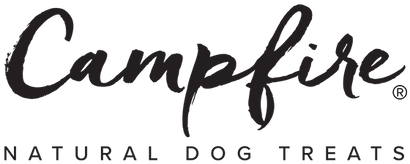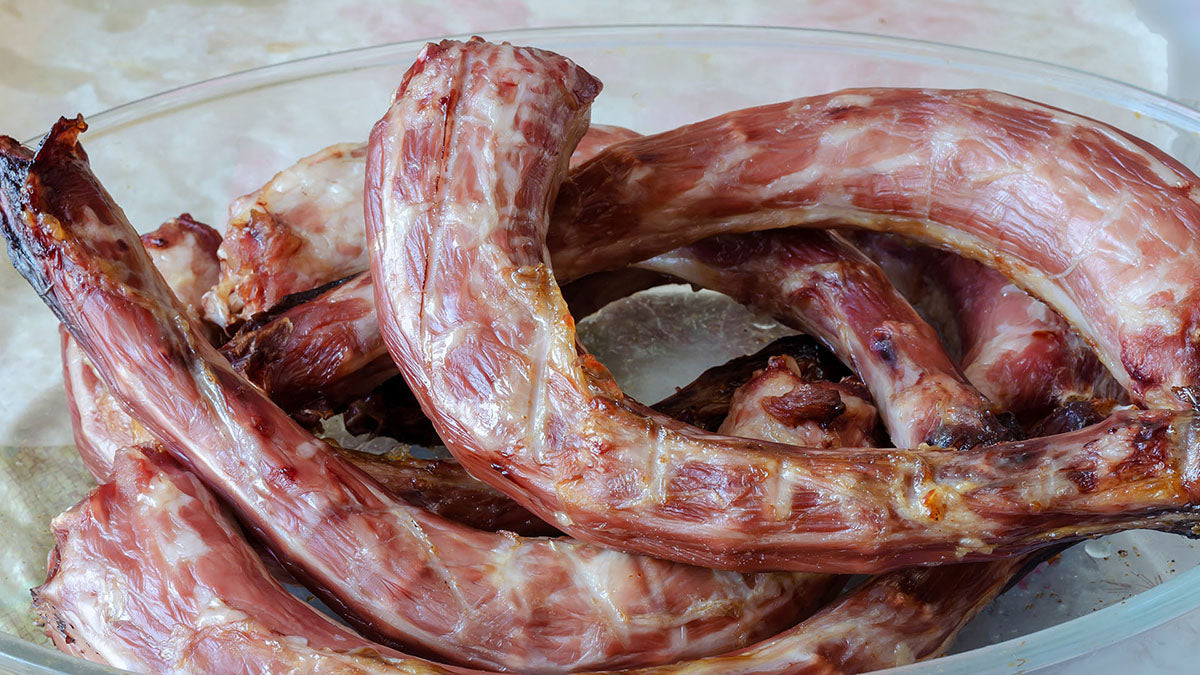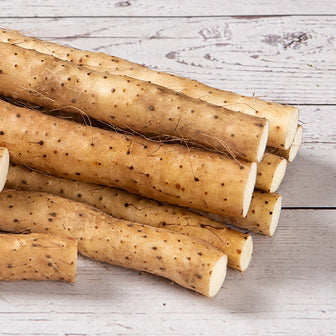Turkey necks can offer many benefits to dogs. They’re a popular choice among natural feeders and may support dental health, joint mobility, and more. In this article, we’ll walk you through everything you need to know before adding turkey necks to your dog’s diet.
Can dogs have turkey necks?
Yes, turkey necks can offer a range of nutritional and health benefits to dogs and can be safely given to most canines. When offered in the right way, they can be a wholesome addition to your dog’s diet and serve as a satisfying chew. However, it’s essential to understand how to feed them properly to ensure they’re both safe and beneficial.
Aren't poultry bones dangerous for dogs?
Most of us have been told never to give a dog poultry bones. While this advice is common and well-meaning, it’s only partly true. The key difference is how the bone is prepared.
Cooked or fried poultry bones
Dogs should never be given the bones of cooked, boiled, or fried turkey, chicken, or other fowl. Research shows that when poultry bones are heated to high temperatures, they lose their collagen and become hard and glass-like. If dogs chew on these, the bones can break into sharp splinters, which can cause serious injuries.
Raw, freeze-dried, or dehydrated poultry bones
Raw, freeze-dried, or dehydrated poultry bones are considered safe for dogs to chew, especially when they come from poultry parts such as necks and feet, where the bones are surrounded by meat, connective tissue, and, in the case of feet, skin. These poultry parts make nutritious chews that are generally well digested by healthy dogs, and can be used as an occasional treat or a component of a dog’s complete and balanced diet.
Benefits of turkey necks for dogs
Turkey necks can offer a wide range of benefits for dogs. They are highly nutritious, support canine dental health, contain glucosamine and chondroitin (which are known to support joint health), and can contribute to a dog's mental health and overall well-being.
Nutritional benefits of turkey necks
Turkey necks provide many nutritional benefits to your dog's diet. A turkey neck consists of about 55% meat and 45% edible and fully digestible bone.
- The meat is a rich source of protein, fat, connective tissue, cartilage (a source of glucosamine and chondroitin), vitamins, and trace minerals.
- The bone additionally provides collagen, calcium, and phosphorus.
Turkey necks can contribute to the dental health of dogs
Turkey necks are healthy dental chews for dogs. When your canine is eating turkey necks (and other suitable chews), the chewing action can help reduce plaque and tartar build-up, resulting in cleaner teeth and gums.
Why is dental care for dogs important?
Dental disease is one of the most common health issues in canines. Studies show that 80–90% of dogs over the age of three have some level of gum disease. According to the State of Pet Health report by Banfield Pet Hospitals, the number of dogs with dental disease has gone up by about 23% since 2006 and continues to rise each year.
Dental care for dogs is essential. When plaque and tartar are not removed, bacteria can creep under the gumline, causing painful gingivitis and periodontitis and loosening or even fracturing teeth. If gum disease isn’t treated, the infection can spread to the tooth roots and jawbone, causing painful abscesses and sometimes the need for tooth removal. The bacteria can also enter the bloodstream and harm major organs like the heart, liver, and kidneys. In severe cases, it can even lead to sepsis, a dangerous, life-threatening infection.
Why are turkey necks a safer choice than elk antlers or marrow bones?
The important difference between turkey necks and elk antlers or large marrow bones is that the bone segments (vertebrae) in the turkey neck are relatively soft and pliable, minimizing the risk of cracked teeth. Countless reports from veterinarians show that large load-bearing bones such as cattle femurs and elk antlers are too hard for dogs to safely chew on, leading to broken teeth.
Turkey necks can contribute to the joint health and mobility of dogs
Many studies show that giving dogs glucosamine and chondroitin by mouth can help with joint health and mobility, especially in dogs with osteoarthritis. If your dog has this type of arthritis, your veterinarian will likely suggest these supplements. Glucosamine and chondroitin occur naturally in the cartilage and connective tissue of turkey necks and are easy for dogs to digest. Adding turkey necks — or other cartilage-rich foods like chicken feet — to your dog’s diet may help reduce discomfort and improve mobility.
Turkey necks can contribute to the mental and overall health of dogs
Turkey necks are fun for your dog to chew on and are a great way to provide entertainment and mental stimulation. Gnawing on a large turkey neck provides physical exercise that involves the jaw muscles as well as the neck, legs, shoulders, and back, since dogs often plant their front feet on the bone to fix it to the ground. Lastly, turkey necks are an easy way to add variety to an often-monotonous diet for our canines.
“When selected and fed the right way, turkey necks can be a safe, healthy, and enjoyable addition to many dogs’ diets.”
Dr. Léa Engelman, DVM
Risks of giving turkey necks to your dog
Despite their benefits, turkey necks may also pose risks to dogs, which include:
- Choking hazards: Like any large chew, turkey necks also pose a potential choking risk for dogs. This is especially true for smaller canines and those who tend to gulp their food rather than chew it properly.
- Constipation: Turkey necks contain considerable amounts of bone. Calcium in the bones hardens the stool and can therefore cause constipation if eaten in too-large amounts.
- Blockages: If dogs don’t chew turkey necks well, they can swallow large pieces that may cause blockages in the esophagus or digestive tract.
- Pathogens: If fed raw, turkey necks may contain foodborne pathogens such as Salmonella, E. coli, or Listeria.
Which dogs can get turkey necks?
Turkeys are large fowl. Their long, flexible necks consist of 14 interconnected segments of bones. The neck of an adult male turkey can easily reach 10 to 12 inches in length and can exceed one pound in weight. They should therefore only be given to dogs that can safely chew items of this size.
Can small dogs eat turkey necks?
No, small dogs should not get turkey necks. The bones within the neck may pose a choking risk. A whole turkey neck would also provide too many calories to be a suitable treat for a small dog. Smaller breeds are better off with more appropriately sized chews, such as duck or chicken necks, which offer comparable benefits.
Can medium-sized and large dogs eat turkey necks?
Yes, turkey necks can be an ideal addition to the diet of medium-sized and larger dog breeds. They may be given either as a recreational treat or as part of a regular, nutritionally balanced meal.
Hungarian vizsla eating a dehydrated turkey neck
Which dogs should not get turkey necks?
There are several scenarios when dogs should not be given any turkey necks. These include:
- Immunocompromised dogs: Raw turkey necks are not recommended for young puppies with immature immune systems. The same caution applies to dogs with compromised immune systems, since raw meat can harbor pathogens such as Salmonella, E. coli, or Listeria. If you feed your dog raw meat, be mindful of other people in your home. Babies, young children, pregnant people, older adults, and anyone with a weakened immune system have a higher risk of getting sick from handling contaminated food or from contact with a pet’s saliva or feces. If you also have a cat, pay close attention to bird flu (avian influenza). This virus can spread through raw or undercooked poultry and is extremely dangerous for felines, causing severe — and sometimes fatal — breathing and neurological problems. Dogs seem to be less likely to get seriously ill from it.
- Dogs with allergies or sensitivities towards turkey: If a dog is allergic to turkey or shows sensitivities, such as itchy skin or digestive issues, it should not be given any turkey necks or other turkey meat.
- Gulpers: Dogs that tend to gulp down their food without proper chewing should not get turkey necks, as these large chews would pose a choking risk (see safe feeding advice).
- Dogs with loose or many missing teeth: Grinding down a turkey neck requires intensive chewing. Dogs with loose or many missing teeth (especially molars) should therefore not be given any turkey necks.
- Dogs with digestive issues: Canines whose digestive systems do not tolerate larger amounts of meat should not be given turkey necks. If your dog only struggles with raw meat, try dehydrated or freeze-dried turkey necks instead.
- Dogs with chronic health conditions: Dogs with certain chronic health conditions also need special consideration. Dogs with histories of pancreatitis, inflammatory bowel disease, chronic vomiting or diarrhea, obesity, diabetes, or chronic kidney or liver disease should only receive turkey necks under direct veterinary guidance, if at all. For many of these patients, lower-fat, highly digestible, or prescription diets are a better option than rich, chewy treats.
- Small dogs: Toy breeds and small dogs should not get turkey necks, as they can pose a choking risk. Turkey necks also provide too many calories for small dogs.
How to safely give turkey necks to your dog
To ensure turkey necks are a safe, healthy, and fun experience for your dog, we recommend following these guidelines:
- Check if your dog can have turkey necks: First, make sure your dog is a good candidate for turkey necks using the guidelines above.
- Preparation is key: Make sure to only give your dog fresh, frozen, dehydrated, or freeze-dried turkey necks. Never give your dog cooked or fried turkey necks!
- Food safety and hygiene: Raw meat and raw bones should always be handled with care. Wash your hands thoroughly with soap and warm water after touching raw turkey necks, and clean any surfaces, utensils, or bowls that come into contact with raw meat. Store necks in the refrigerator or freezer and never leave raw poultry at room temperature for extended periods. These simple food safety steps help protect both your dog and your human family members from foodborne illnesses.
- Supervise Chewing: Always give your dog turkey necks when you can watch them. Your dog should be calmly lying down or standing in one spot while chewing, so you can see how they’re breaking apart the neck and swallowing the pieces (see video above).
- Address “Gulpers”: If your dog tends to swallow food whole without chewing properly, turkey necks may not be the best choice. If you do decide to offer them, hold one end of the neck while your dog chews the other so they must work on it, then remove it once it becomes small enough to pose a choking risk.
- Remove skin/fat: If you feed raw turkey necks, remove the fatty skin (if still attached) before giving them to your dog.
- Try frozen: On hot summer days, frozen turkey necks are a great way to provide cooling enrichment. Because frozen necks are more rigid, they usually last longer and extend the chewing experience, but they should still be offered under close supervision.
- Start slow: If you are giving your dog turkey necks for the first time, start with small portions to see how your dog’s digestive system handles the new food.
- Pay attention to proper hydration: Always provide your dog with plenty of fresh water. This is especially important when giving them freeze-dried or dehydrated turkey necks.
Please be aware that no bone, chew, or treat is entirely risk-free, even when you follow all safety guidelines. Contact your veterinarian immediately if you notice vomiting, loss of appetite, constipation, diarrhea, lethargy, or signs of abdominal pain after your dog eats a turkey neck or any new chew or food.
If you’ve never given your dog a turkey neck, also keep in mind that it can be messy. We therefore recommend feeding this chew outside.


Raw, dehydrated, and freeze-dried turkey necks for dogs
Which turkey necks should not be given to a dog?
A simple rule is that if a turkey neck has been prepared for human consumption, it cannot be given safely to dogs. Examples include:
- Roasted, fried, cooked, or braised turkey necks: These should never be given to dogs, as poultry bones, when heated to cooking temperature, become glass-hard and unsafe.
- Necks prepared along with your Thanksgiving turkey: These are a big no. By the time the holiday turkey reaches the table, the neck has been cooked at high temperatures and usually basted or roasted with butter, oil, salt, and other seasonings. Even if you remove sauces, the bone is brittle from cooking, and the meat is still seasoned for humans, not dogs.
- Smoked turkey necks: These have likely been heated to cooking temperature (which makes them dangerously hard), and they are typically heavily spiced, so they should therefore not be given to dogs.
- Turkey necks with skin: These should not be given to dogs as turkey skin, especially the sections around the neck, are extremely fatty.
How much turkey neck should I give to my dog?
If your dog is not used to raw meat, we suggest that you start slowly when introducing turkey necks. Giving small amounts once or twice per week will allow your dog’s digestive system to adjust to the new addition to their diet.
- Small dogs: None. Small dogs are better off with smaller chews, such as duck or chicken necks.
- Medium dogs: One-half turkey neck up to three times per week.
- Large dogs: One whole turkey neck up to two, three times per week.
Depending on your dog’s diet and activity level, you may want to slightly reduce their regular food on days you give a turkey neck, since it adds extra calories. Always make sure your dog has plenty of fresh water, especially when eating freeze-dried or dehydrated turkey necks. If your dog’s stool becomes dry, very firm, or chalky, cut back on how often or how much turkey neck you give.
Where can I buy turkey necks for my dog?
Raw turkey necks (fresh or frozen) are often available at farmers’ markets, butcher shops, and in the meat departments of some grocery stores. If you are not into raw feeding, go for freeze-dried or dehydrated turkey necks instead, which can be found online or in well-assorted pet supply stores.
When buying turkey necks, we strongly advise against products imported from China. While they may be slightly cheaper than U.S.-made dog chews, various pet food recalls over the last years indicate that not all Chinese manufacturers have implemented sufficiently effective quality control measures. Choosing regionally sourced products from companies with transparent quality control is a safer option.
What are alternative chews to turkey necks?
There are several other all-natural, healthy chew options you can give your dog instead of turkey necks. Examples include:
- Duck or chicken feet: These are safe chews for dogs of all sizes. They consist mainly of small bones surrounded by cartilage, ligaments, and skin. Duck and chicken feet are naturally rich in glucosamine and chondroitin and can contribute to the joint health and mobility of your dog. Dehydrated or freeze-dried feet are also dental chews that can help reduce plaque and tartar buildup.
- Duck or chicken necks: These are ideal chews for small to medium-sized breeds. Their benefits are comparable to those of turkey necks.
- Beef trachea: Because of its size, beef trachea is best suited for medium to large dogs. It is made mostly of cartilage and is rich in glucosamine and chondroitin for joint support, and if dehydrated, it can also offer dental benefits.
- Bully sticks: Available in different thicknesses and lengths, bully sticks are therefore options for dogs of all sizes and chewing strengths. Thinner bully sticks are ideal for puppies and seniors, while extra-thick options are better suited for power-chewers.
Conclusion
Turkey necks can be a healthy and enriching addition to many dogs’ diets when chosen and fed correctly. With mindful feeding and proper supervision, they can be a safe and enjoyable part of your dog’s routine. Always take your dog’s size, health, and chewing habits into account — and when in doubt, consult a holistic veterinarian or board-certified veterinary nutritionist.














